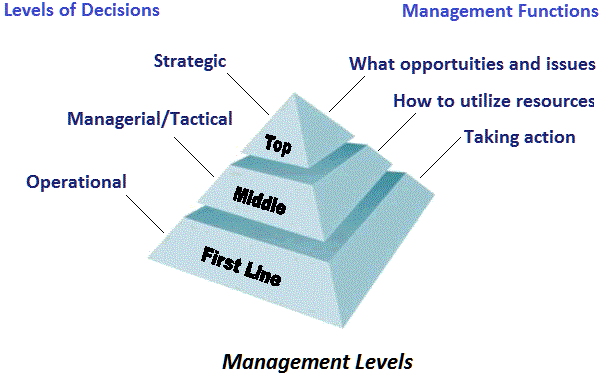Section 1: Decision Levels in an Organization
Since information can best be studied in the context of its use, one needs to study the information characteristics and the information process in an organization.
One way to study this is to look at the organization in terms of a hierarchy of decisions.

Operations Management – lowest level of management in which decisions affect daily operation
- function – oversee operating details of the organization, insuring that basic tasks are performed on time and in accordance with organizational constraints
- decisions – concerned with routine operations
- decision-making environment – characterized by high degree of certainty
- information needs – repetitive, low-level details, interested in current performance or real-time information
Middle Management – intermediate level of management in which decisions involve short-term planning and control decisions
- function – forecast resource requirements and monitor productivity
- decisions – focus on how to utilize resources to meet objectives
- decision-making environment – characterized by uncertainty and is semi-structured
- information needs – both short- and long-term information; need historical information as well as information that allows prediction of future events and simulation of possible scenarios
Strategic Management – upper level of management in which decisions guide middle and operations management in years ahead
- function – determine product lines, divestitures and acquisitions
- decisions – focus on the opportunities for new locations, overseas operations, changing price structures, etc.
- decision-making environment – highly uncertain and unstructured
- information needs – information from external sources about market trends and competing strategies; require predictive information; require highly general, summarized information
Section 2: Impact of Decision Levels on Information Requirements
Each decision level requires a different type of information.
The factors that characterize information needs are:
- Time horizon – the time horizon of the decision increases with each level of management. Strategic decisions must look much farther ahead (predictive) than operational decisions (programmed).
- Type – At the operating level and moving toward the managerial level, decisions can be clearly identified and in many cases are guided by rules which make the decisions programmable. At higher decision-making levels, a heuristic dimension of imagination and creativity characterize decisions, and require human involvement.
- Length – Length refers to the time that elapses between recognizing an opportunity and making a choice and implementing it.
- Uncertainty – at higher levels of decision making the amount of risk increases and uncertain future events play a significant role.
- Frequency – At the operating level, decisions tend to be highly repetitive, while at the managerial level they are repeated relatively infrequently. At the strategic level a certain type of decision may only have to be made once.
- Data source – At the operating level data comes from monitoring the resources within the organization. While this involves relatively small areas, they are examined in great detail. The managerial level involves a broader picture in less detail. The strategist is concerned with the organizational environment.
Section 3: Differences in Data Between Operating and Strategic Levels
| Operational Level | Strategic Level |
|---|---|
| Historical | Projected |
| Detailed | Summarized |
| Internal | External |
| Frequent | Rare |
| Current | Trends |
| Accurate | Approximate |
Section 4: Organizations as Systems
- composed of subsystems
- interrelated and interdependent
- contained by boundaries
- environment
- open systems vs closed systems





